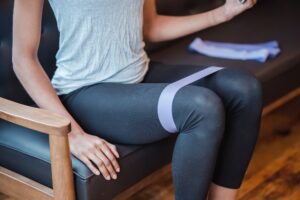Are you concerned about staying in shape at home or while traveling? Regardless of whether you’re trying to lose fat or gain muscle, staying at home or traveling can halt or even hinder your progress because your daily routine is disrupted, you’re constantly busy, and you may not have access to a gym. The good news is, however! With resistance band exercises, you can maintain or even improve your fitness level anywhere, at any time. Utilize these tips to maintain your health and return even stronger than before!
Tips To Maintain Good Health
1. Carry Your Gym With You
Instead of settling for whatever is available, try a portable resistance-training workout. A set of resistance bands with door anchor and ankle strap attachments, loop bands, and a jump rope are three of the best items to include for both men and women. In addition, you should bring a flat band, which is ideal for pre- and post-workout stretching.
All of these are portable and lightweight, allowing you to perform strength training and cardiovascular exercise in your hotel room or outside.
2. Utilize Resistance Band
Resistance bands offer a distinct advantage over free weights because they create tension throughout the entire movement, necessitating greater control. This form of resistance will increase the recruitment of muscle fibers for improved results by requiring constant muscle contractions. In addition, they allow you to work from a greater variety of angles, allowing you to accomplish more with less equipment and enhancing your mobility and flexibility.

Using a door anchor with resistance bands expands your exercise options for the entire body, while an ankle strap simplifies leg and glute exercises. Loop bands will allow you to perform a wider variety of lower body exercises with greater efficiency than when using only your body weight. These are also excellent for activating the glute (butt) muscles. By activating them prior to heavier leg exercises such as squats and lunges, you will achieve better results because you will be using the correct muscles to perform the exercise, rather than relying on stronger muscles such as quads and hamstrings.
Even if you’re a seasoned gym rat, switching to bands while on vacation will stimulate your muscles in novel ways, which is a helpful technique for breaking through plateaus!
Because different muscle groups require varying levels of resistance, be sure to bring 2-4 resistance bands. See below for examples of travel-friendly workouts.
3. Perform High-Intensity Cardiovascular Exercise
Keep your cardio sessions brief but efficient. High-intensity interval training (HIIT) and Tabata are excellent methods for achieving this. Both types of exercise involve performing the movements with maximum effort for a brief period of time, followed by a brief period of rest.
For Tabata, this appears to be eight rounds of 20 seconds on and 10 seconds off. For HIIT, there is greater flexibility, but a 30-second on, 1-minute off interval may be used. The key to both approaches is to work as hard as possible during the work period (we’re talking sprints, not jogs) and then rest completely to allow your heart rate to return to its resting level.
The advantage of both is that you only need your own body weight. This is also possible on any cardio equipment. You’ll likely burn the same number of calories as you would during the longer duration, steady-state cardio, plus you’ll use more muscle, which burns additional calories after exercise.
Example HIIT:
- 30 seconds of jumping rope, sprinting, or running stairs
- Rest – 1 minute
- Total repetition time: 15 to 20 minutes
Example:
- Mountain climbers for 20 seconds (rest 10 seconds)
- Skipping rope – 20 seconds (rest 10 seconds)
- Squat jumps – 20 seconds (rest 10 seconds)
- Burpees – 20 seconds (rest 10 seconds)
(Repetitions: 8)

Example Exercises
Start with the following warm-up, and then perform 3 to 4 sets of each exercise in a circuit or individually (if one at a time, rest 30 seconds between each set).
Warm-Up (using a flat therapy band, perform 15-20 reps of each) (using a flat therapy band, perform 15-20 reps of each)
- Passages through
- stooped over rows
- Pull-apart
- Squats (standing on the band, holding ends in each hand by shoulders) (standing on the band, holding ends in each hand by shoulder)
- Jumping jacks
Upper Body Resistance Band Workout
- Plank – 1 minute (no band needed)
- Back row (anchor indoor) –15-20 reps
- Defiant push-ups (with flat band)– 10-15 reps
- Alpine climbers (no band needed)
- Bicep curl – 15-20 reps
- Shoulder press – 12 to 15 repetitions
- Triceps Extensions – 15-20 reps
Lower Body Resistance Band Exercise
- Lateral walks (place loop band around lower thighs) – 15 in every direction
- Glute bridge (place loop band around lower thighs) – 20 reps
- 15-20 repetitions of squats with a band held at the shoulders.
- Jump rope – 1 minute
- Positional lunges (holding band in hands at shoulders) – 10 to 12 per leg
- Glute kickback (using ankle cuff and door anchor) 15 repetitions per leg
- 15 repetitions per leg of ankle cuff and door anchor leg extensions.
- Jump rope – 1 minute
Full-Body
- Plank -1 minute
- Rotations of the core (anchor indoor) – 12 reps per side
- Fire hydrants (with loop band around lower thighs) – 12 per leg
- 15 reps of squats with bicep curls
- 15-20 repetitions with the bent-over row
- Jump rope – 1 minute
- 10 repetitions of lunges with shoulder presses per side
- Burpees – 10 reps
Be sure to stretch the hamstrings, quadriceps, glutes, chest, back, and shoulders at the end using a flat band.
- Which resistance band exercise are you most excited to try in your next workout?
If you enjoyed this blog post, share it with your friends!
